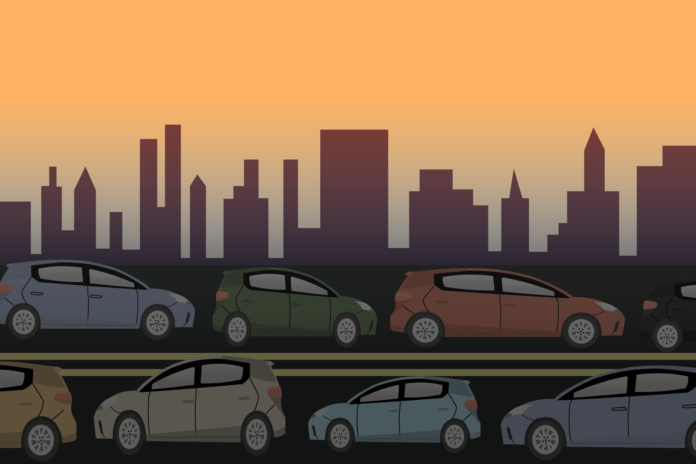California’s air quality problem will get worse, especially for people of color, if the government doesn’t take meaningful action
Especially in recent years, California has often been portrayed as the most environmentally conscious state. A variety of things have contributed to this portrayal, like Gov. Gavin Newsom’s executive orders on the environment which have prioritized protecting 30% of the state’s land and ocean for conservation and paved the way to phase out gas vehicle sales over the next decade. Despite these promises, what exactly has California done to address equitable transition away from fossil fuels?
A recent UC Berkeley study found that over the past quarter century, California has cut air pollution by nearly 80%. This might sound impressive on the surface, but considering that conditions 30 years ago were some of the worst in the world, this isn’t that impressive. California cities account for four out of five of the worst ozone and year-round particle polluted cities in the nation. They also add up to be three out of five of the worst short-term particle polluted cities. So how can California be one of the most sustainable and one of the most polluted states in the country?
There is a systemic irony to how California has treated environmental issues. California’s system promotes sustainability for those who can afford it—leaving behind low-income and marginalized communities to fend for themselves. Over the past few decades, the disproportionate impact on the health and living standards of communities of color by environmental pollution has been well-documented, yet California has been slow at best to explicitly protect these communities.
For instance, take a look at how California regulates carbon emissions. Its cap-and-trade program went into effect in the mid-2000s and was originally hailed as a great compromise and a good step toward combating climate change. Cap-and-trade programs work by having the state set a specific limit on carbon emissions each year and then allocating a limited number of permits that each allow for a specific amount of emissions. Additionally, businesses can get credits from other companies that remain under the limit. This has ultimately allowed big polluters that are predominantly based in communities of color to continue at their current emissions levels by just buying credits from other companies.
“As warned by environmental justice advocates, cap and trade has increased pollution hotspots for two communities of color in California, exacerbating pollution health and safety harms,” stated dozens of environmental organizations in a letter to the Biden administration. “The cap-and-trade program and other market mechanisms—which commodify the source of the climate crisis that most severely threatens global communities of color and low-income people—account for a modest reduction of greenhouse gas emissions and has not been successful in meeting California’s climate goals.”
Across the board, some industries may have reduced emissions because of this policy, but the companies that haven’t are the biggest polluters. These companies, like oil refineries, are overwhelmingly located in low-income communities and communities of color—and California is one of the top 10 oil producers in the country. The state’s environmental policies have worked for the white upper middle class, who up until recent years have dominated conversations around environmentalism and membership within groups like the Sierra Club.
Environmental racism is prevalent across the state from Chevron’s refinery placement in Oakland to the toxic release sites that are spread across Los Angeles. Los Angeles actually has the worst air quality in the nation when looking at ozone pollution, with 71% of its Latinx residents living in areas with the worst air quality. You’d think that the decrease in car traffic in Los Angeles due to the pandemic would have impacted this pollution, but the air quality is so bad that it didn’t even make a noticeable difference.
“We learned unambiguously that if you just take half the cars off the road, that cleans up the CO2 quite a lot, but CO2 doesn’t contribute to smog,” said Ronald Cohen, a professor of atmospheric chemistry at UC Berkeley to the LA Times. “And that removing half the vehicles is not enough to control smog in LA. So you can’t just cut driving and stop smog, unfortunately. It’s possible that with cars we’ll only be clean enough when we go all electric.”
Individual actions are important, both symbolically and literally, but structural change is what is going to make a difference to entire communities. The pandemic allowed us to see unequivocally what would happen if the majority of consumers stopped using cars even for a brief moment, and it just reinforced that the burden of pollution should be on companies, not consumers. California’s environmental issues, especially air quality, must be addressed equitably if we are to truly fight climate change. It’s absurd to continue to put out vague goals that don’t address the largest polluters and ignore the impacts of environmental issues on those who are affected the most. If the government doesn’t start regulating extractive industries, they will continue to profit off of exploiting marginalized communities.
Written by: Joe Sweeney — jmsweeney@ucdavis.edu Disclaimer: The views and opinions expressed by individual columnists belong to the columnists alone and do not necessarily indicate the views and opinions held by The California Aggie.




